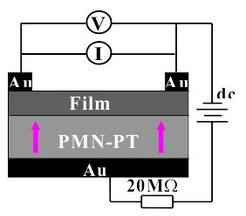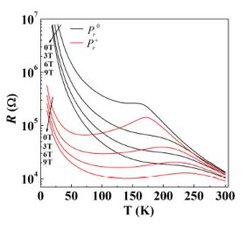Epitaxial Strain and Strain Accomodation
Due to the delicate interplay of spin-, charge- and orbital- degrees of freedom with the lattice in complex oxides we investigate the macroscopic properties of manganites (resistivity, magnetism) as a function of epitaxial strain and explore subsequently mechanisms of strain relaxation. Early experiments demonstrate in a case study the strain-induced transition of an antiferromagnetic thin film to a ferromagnetic metal.[1] To further explore epitaxial strain formation and relaxation we grew epitaxial La1/2Ca1/2MnO3 thin films of different thickness on (100) SrTiO3 (STO), (111) STO, and (001) SrLaGaO4 (SLGO) substrates by the pulsed laser deposition method. Electrical and magnetic properties of these films are completely different from the bulk material. By using the substrate material as a knob to tune the film properties, a wide range of phases from an insulator in the entire temperature range between 5 and 300K to a metallic, even at temperatures close to room temperature, can be stabilized, although chemical compositions, deposition conditions, and thicknesses are kept constant. Finally, it is observed that metallic behavior generally dominates in samples with low structural distortions while large distortions are accompanied by the insulating behavior. [2]
To disentangle the contributions arising from interfacial strain due to film and substrate lattice mismatch from other sources of strain (e.g. due to growth, thermal expansion mismatch etc.) we investigated manganite thin films on ferroelectric 0.67Pb(Mg1/3Nb2/3)O3 (PMN-PT) - single crystal substrates where the concept of ferroelectric poling-induced strain was used [see Fig. 1].

In these experiments the strain effect on e.g. resistivity of films with identical microstructure and oxygenation can be investigated due to the continuous change of the in-plane lattice parameter by ferroelectric poling of the substrate. It was shown that the ferroelectric poling induced a reduction in the in-plane tensile strain in the LaMnO3 film, giving rise to a weakening of the electron-lattice coupling and thus a decrease in the resistance and an increase in the ferromagnetism and Curie temperature (TC) of the film [see Fig. 2].[4]

Fig 2: Ferroelectric poling induced reduction in resistance of a LaMnO3+δ thin film.
The induced reduction in the in-plane tensile strain leads to opposite effect on magnetoresistance (MR) below and above TC, namely, MR is reduced for T<TC while MR is enhanced for T>TC. These strain effects on magnetic and magnetotransport properties are closely related to the phase separation which is found to be suppressed in the ferromagnetic state but enhanced in the paramagnetic state as a result of the ferroelectric-poling-induced strain. [3-5]
References
[1] Epitaxial strain induced metal insulator transition in La0.9Sr0.1MnO3 and La0.88Sr0.1MnO3 thin films. Razavi F.S., et al. Appl. Phys. Lett. 76, 155 (2000).
[2] Structural and electrical properties of La0.5Ca0.5MnO3 films deposited on differently oriented SrTiO3 substrates. Aydogdu G., et al. Mat. Sci. and Engineering 144, 123 (2007).
[3] Effect of ferroelectric-poling-induced strain on the phase separation and magneto-transport properties of La0.7Ca0.15Sr.15MnO3 thin films grown on ferroelectric single-crystal substrates. Zheng R. K. et al. Phys. Rev. B 80, 104433 (2009).
[4] Effects of substrate-induced strain on transport properties of LaMnO3+delta and CaMnO3 thin films using ferroelectric poling and converse piezoelectric effect. Zheng R. K. et al. Phys. Rev. B 81, 104427 (2010).
[5] Interface strain coupling and its impact on the transport and magnetic properties of LaMnO3 thin films grown on ferroelectrically active substrates. Zheng R. K. et al. J. of Alloys and Compounds 124, 3807 (2012).

